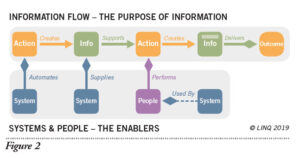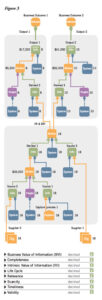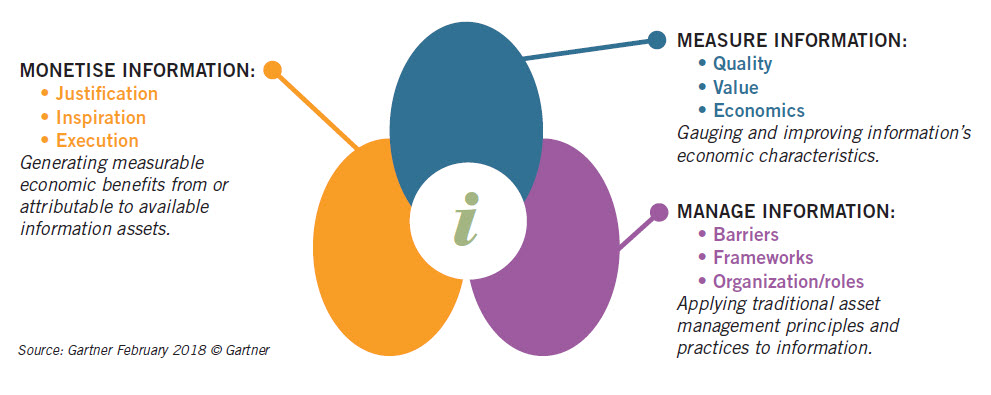Role of Infonomics Applications in enabling IG
[glossary_exclude]Master of your own Domain
As demands on data and analytics to support successful decision-making increases, implementing an Information Governance strategy that goes beyond “we store everything” will be of critical importance. Investment into data & analytics work supports a wide range of business drivers such as improving operational cost efficiencies, business transformation, and overall business agility.
Not all data is equal, which means there cannot be a single view of IG. New privacy roles, such as the GDPR’s Data Protection Officer (DPO), help users view data and the information it produces in new ways. Coupled with the principles of Infonomics—the measurement, management, and monetization of data—creating an effective IG strategy should be an evolving and graduated approach that acknowledges the value of an organization’s information assets.
Figure 1 – Infonomics Model; Measure, Manage, and Monetize Information
IG requires consideration of all four pillars of the business; people, process, technology, and information. It is the combination of these pillars that will ensure that IG principles are successfully adopted across the business. Executive sponsorship, stakeholder consultation, information policy development/communication, information integrity, information organization/classification, information security/privacy, information accessibility, information control, information monitoring/auditing, and continuous improvement are significant elements of an IG program.
Getting started can be challenging. Take the wrong approach and correction can be expensive. Although “Master Data Management” is where many businesses end up, the answer to the fundamental question of “what is my master data” remains elusive. Infonomics provides an approach to IG based on the value of information to the business. By understanding how information contributes to business outcomes, a methodology can be applied to assist in the prioritization of the work needed to implement effective IG.
When Infonomics is implemented into a platform that accelerates the discovery of information value across the organization, the starting point for the IG conversation shifts to business value. If Infonomics is to assist in the development of the IG Strategy, the business must manage information as an asset. This requires new thinking based on the who, what, where, when, and why of information. These are the questions that need to be answered if an IG strategy is to be based on the value of the contribution of information to the business based in evidence rather than opinion.
LINQ brings Infonomics to life in a simple way so that information can be managed as an asset. LINQ informs business owners of the value of their information so that it can be applied in new ways to deliver business success.

Figure 2 – The LINQ Language; building a Digital Twin of the business
LINQ models the relationships between the four business pillars (people, process, technology, and information) from the perspective of how information flow delivers business outcomes. This model, or “Digital Twin,” becomes a representation of what really happens as information flows from source (data) to output (assets that enable a business outcome) per the LINQ language (see figure 2).
By understanding the value of the information that enables the outcome at the end of the information flow, the value of the people, systems, processes, and interim information that enables the ultimate asset to be created, can be identified.
The LINQ graphical workflow models and correlates data inputs, preparation and transformation steps, reporting outputs, business decisions, actions arising, and resulting business outcomes. It enables analysts to communicate and make transparent the true business impacts of different information, surface hidden dependencies and evaluate the impacts of any changes to the information, systems, and people needed to achieve business success. By orchestrating the organization’s understanding of its people, systems, and information, and value in business terms, LINQ helps to proactively facilitate a robust approach to IG.
These insights are critical to the development of an IG strategy that will support activities to protect information of value whilst ensuring information of lower value is de-prioritized in terms of overall governance.
Once the information flow is understood, the full principles of Infonomics can be applied through the model to build a comprehensive value perspective. Of interest are Business Value Index (BVI) and Intrinsic Value Index (IVI). By recording the validity, completeness, scarcity, and lifecycle of the information created by people and systems, BVI can be calculated as information traverses the business. When business relevance and timeliness are included, IVI is understood (see Figure 3).

Figure 3 – Infonomics in LINQ – measuring BVI and IVI
Including these quantifiable and qualify-able Infonomics-based data into an IG framework ensures that business value is the driver for your strategy, not the varied opinions of the people who believe their information is the most critical.
As platforms like LINQ come onto the market, perhaps the most compelling reason for considering them is their ability to increase the level of discipline applied to managing information, treating it as the valuable asset it is. Through these new, value-based insights, the work required to develop and implement Information Governance strategies will become simpler, evidence-based, and more easily achieved. Thus, Infonomics software applications enable Information Governance programs to be more successful.[/glossary_exclude]
recent posts
You may already have a formal Data Governance program in […]

